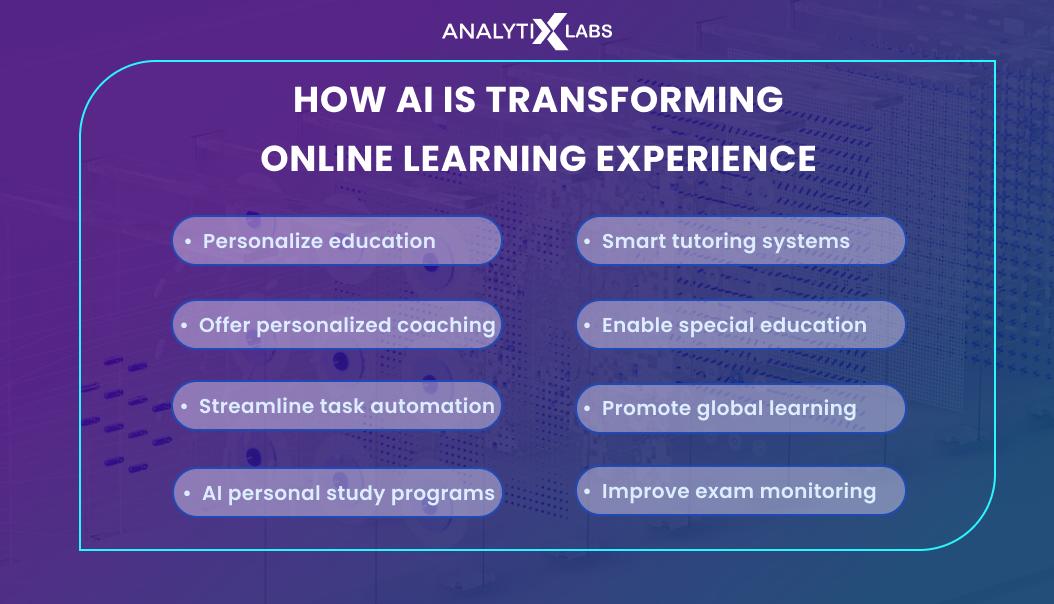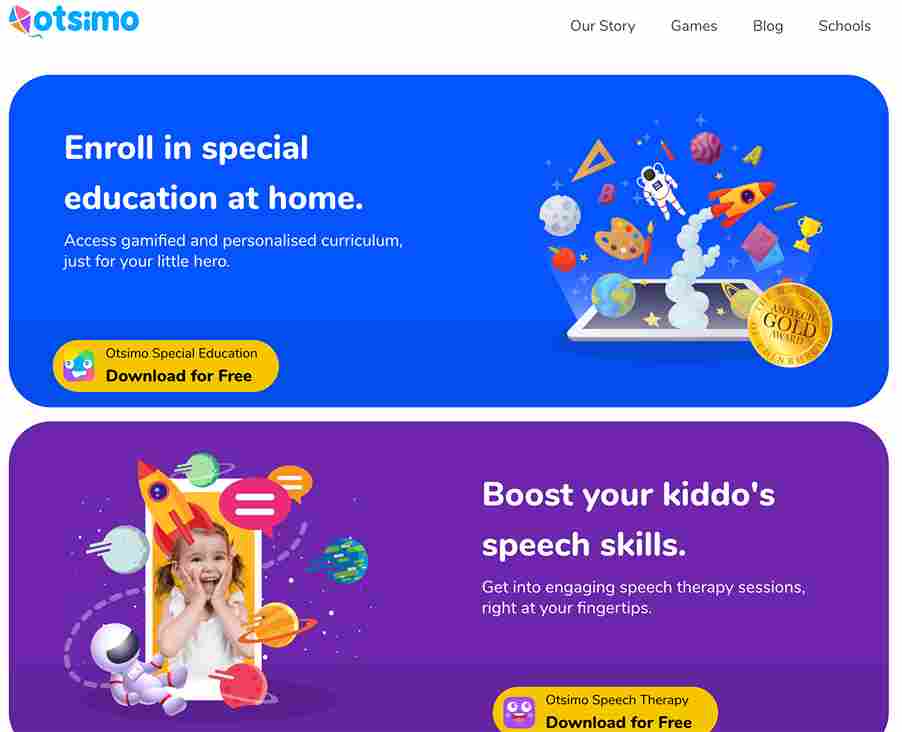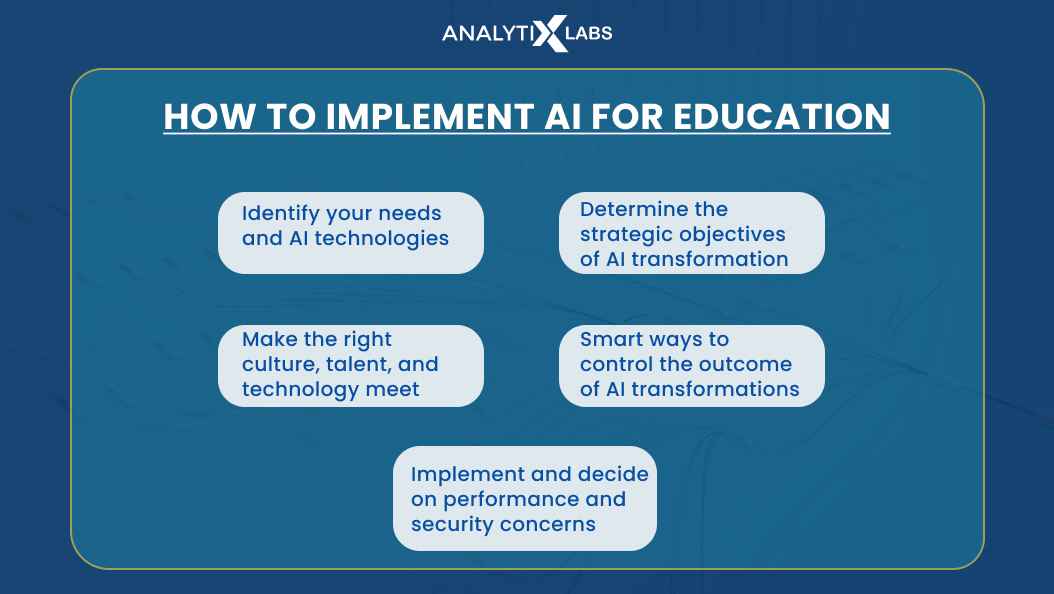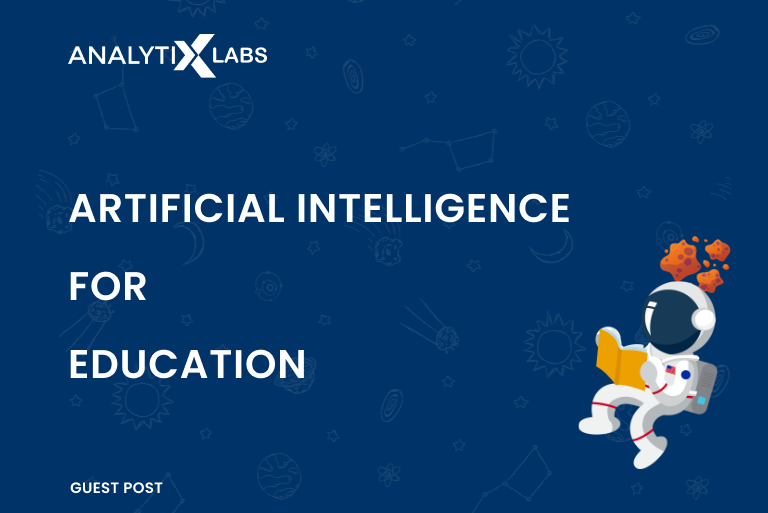Artificial intelligence is the science that produces and studies machines that can stimulate the human intelligence process. AI aims to optimize routine processes and improve speed and efficiency. As a result, the number of companies that adopt AI continues to grow. According to Research and Markets– Analysts forecast AI for the Education market to grow at a CAGR of 47.77% from 2018-2022.
AI tools mostly comply with three basic principles:
- Learning: Acquire and process new experiences and create new behavior models based on these experiences
- Self-correction: Refine the algorithms to ensure you get the most accurate results
- Reasoning: Creating and improving specific algorithms for specific work
AI tools can open up new opportunities in every sector, including education. The adoption of technology is a promising way to transform companies. Let’s take a look at how AI based learning platforms are improving online learning experiences.
AI for Education: How AI helps in Education(online)

Technology is gaining fast global acceptance, and AI transforms how we teach and learn things. AI is a disruptive technology that can be used to customize learning groups, teachers, and tutors.
This is how AI helps in education with various tools that can be applied to study different processes.
Personalize education
Artificial Intelligence helps determine what a student does and does not know, helping us build a personalized study schedule for each learner considering their knowledge gaps. Thought of it this way, AI tailors studies according to students’ specific needs, increasing the efficiency of the entire teaching process.
Companies can train their AIs to cement knowledge gaps, explain complex concepts easily, define how they relate to each other, do more things like this, and finally bridge the digital divide.
Forget about sitting in classes with everyone, being taught things you already know, and skipping to stuff you need more confidence in and want to spend time on.
Many universities tested chatbots for performing repetitive tasks that faculty members could otherwise do. These tasks include answering routine questions from students. For instance, Staffordshire University in the UK and Georgia Tech developed chatbots with the goal of providing 24*7 assistance to students.
According to OxJournal, China uses AI auto-grading, with 1 in 4 schools testing machine learning auto grading that gives suggestions to students based on work submitted.
ITSs can help students learn at their own pace as and when necessary and move them toward learning advanced concepts.
Offer personalized coaching
The immediate benefits in light of producing personalized coaching are as follows:
- Run Digital lessons
- Digital learning interfaces offer plenty of ways to customize options, study guides, bite-sized lessons, and others
- Visualize the information you’re presenting.
For example, you can use the AI-enriched free procreate brush pack and create visuals for the information you want to teach students. New ways of getting information like visualization, stimulation, web-based study environments, and more are now possible through AI.
Besides this, AI generates and updates lessons, keeping information current.
If you’re keeping up with the global trends, you know: that personalization is everywhere. The mainstay with AI is the possibility of training it to perform a long list of tasks, offering AI in such a way as to offer a personalized approach to education.
It’s a universal solution to get a set of tools tailored to the specific needs of learners and educators to optimize their routines, increase efficiency, improve accessibility, and scale the processes.
Streamline task automation
Simplify administrative tasks like grading, assessment, and replying to students that AI can optimize.
For instance, you get vocabulary essentials, real-time corrections, and entire sentence suggestions when writing an email on Gmail. This simplifies email writing. And consider how great it would be to have the same system with learning management systems too.
The AI-based grading tools can display information on each student’s progress and customize the information accordingly.
At the same time, AI can assign routine tasks to itself. This helps teachers concentrate on grading assessments and other things you can’t automate with AI.
Improve personal study programs
Continually improve personal study programs to account for gaps to fill during lessons. Personal tutoring can help students keep up with the course and help teachers with students who struggle to learn things.
AI tutors are great time savers for teachers. Continuously evolving personal study programs consider students’ gaps to fill during individual lessons.
Personal tutoring plus support for students outside the classroom helps learners keep up with the course and explain things to kids. AI-powered chatbots or AI virtual assistants can help students avoid embarrassment when asking for help in front of peers.
A report by McKinsey and Company shows that over 85% of college presidents see a decrease in enrollment numbers as a core issue. Ever since Covid-19 happened, enrollment numbers have gone down a cliff.
50% of those surveyed said the emotional roller coaster they were on made them stop enrolling, and 30% said they couldn’t afford to.
AI streamlines the enrollment process, increases student enrollment, and lowers expenses.
For instance, George State University reduced summer melt by 19%. This increased students who fully finished the pre-enrollment process. AI chatbots gave students the support they needed 24/7, being programmed to answer common questions. They can also learn and add new data to their database as humans answer new questions by analyzing each interaction and collecting them.
P.S. Summer melt refers to students who apply to colleges and get accepted there but fail to enroll there.
Smart tutoring systems
Khan Academy touts itself as one of the biggest online resources for students and teachers.
It’s completely free to use with its many lessons and videos, all free to access on registrations.
AI-enabled Khan Academy helps teachers and students alike while being completely free. Such a personalized electronic tutoring system leans on adaptive learning. AI helps smart tutoring systems with cognitive science and AI.
Learning integrates the curriculum around the student’s individual progress and helps support the effectiveness of individual tutoring and classroom opportunities.
It combines immediate opportunities for practice and provides timely feedback and enrichment. These smart responses to individual needs allow students to learn independently. Personalized learning with AI-powered apps lets teachers tailor lessons through individual learning styles. And speed.
Enable special education
Autism is generally a wide-spectrum disorder, and there’s pressure on schools to facilitate learning that overcomes barriers such as these. The transition to digital mediums during Covid 19 affected students’ mental health, and these issues were amplified for students. This is where AI and machine learning help.
As AI learning improves based on feedback, it can improve itself so that schools can leverage AI tools to offer students support, making learning a smooth experience for teachers and students.
The application called Otsimo helped in this field. They have filters that are rich in exercises and reward mechanisms. Machine learning combines with voice recognition and helps recognize what children say and fill the complete progress bar.

Promote global learning
AI is making more strides in classroom availability for students of differing languages. Presentation Translator is a powerful plugin for PowerPoint that creates subtitles in real time as teachers speak.
This plug-in enables speech translation and recognition with AI so that students can read or hear in their native language, regardless of location. This opens the opportunity to learn languages that are not available in their own language and allows for information to be assimilated.
Improve exam monitoring
Cheating can often be seen as a big issue in colleges. AI based learning platforms can attend to this problem in a big way. This is really useful when students are learning from a remote platform. The software can track students’ microphones, browsers, cameras, and keystrokes.
Facial recognition can also occur when students stay away from their seats or look for information from their books. The proctors collect data in real-time.
This tool is extremely useful for finding suspicious behavior and stemming it immediately. AI proctors can help institutes in a number of different ways.
- Needs a camera for the Zoom video feature. No special hardware is required
- Closes the browser automatically after the exam and sends detailed videos to instructors
- Add reminders to students five to one minute before the exam ends
- Offers browser addon to monitor activity
How to Implement AI for Education?
If you’re considering AI as an option to customize the learning experience, these steps will help you to plan your project.

- Identify your needs and AI technologies: The starting point of implementing any technology is identifying the pain points a particular technology can address and resolve. Find the system bottlenecks and research how AI optimizes these processes.
- Determine the strategic objectives of AI transformation in your organization: In this step, you should finalize and think of what objectives you’ll be able to meet with AI transformation. Determine your appetite – Do you want to be seen as an early adopter or someone who merely follows trends? Are you aware of its drawbacks and how your business will address the objections? Your responses to these questions help you identify a cost-benefit analysis of AI automation.
- Make the right culture, talent, and technology meet: To make the most of AI tools, not only choose the right team or environment because actionable decisions at all levels
- Smart ways to control the outcome of AI transformation: Create an environment that fosters both humans and AI.
- Implement and decide on performance and security concerns.
Concluding thoughts
AI for education is coming into the league to offer:
- Round-the-clock training:AI gives students 100% 24*7 access to education. They can schedule their education based on the time they’re most productive.
- Better engagement:Individual schedules, tasks, and interaction personal recommendations are part of the personal approach.
- Lesser pressure:The lessons students take can be tailored to their individual needs. Different learning groups allow students to stop peer comparison and instead help them focus on their personal goals. Now all you need to do is type a query with a virtual assistant and get an instant explanation of whatever’s troubling you.








